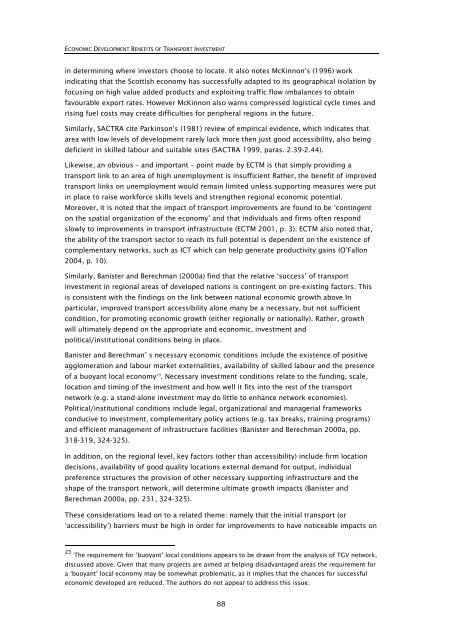Research 350 - NZ Transport Agency
Research 350 - NZ Transport Agency
Research 350 - NZ Transport Agency
Create successful ePaper yourself
Turn your PDF publications into a flip-book with our unique Google optimized e-Paper software.
ECONOMIC DEVELOPMENT BENEFITS OF TRANSPORT INVESTMENT<br />
in determining where investors choose to locate. It also notes McKinnon’s (1996) work<br />
indicating that the Scottish economy has successfully adapted to its geographical isolation by<br />
focusing on high value added products and exploiting traffic flow imbalances to obtain<br />
favourable export rates. However McKinnon also warns compressed logistical cycle times and<br />
rising fuel costs may create difficulties for peripheral regions in the future.<br />
Similarly, SACTRA cite Parkinson’s (1981) review of empirical evidence, which indicates that<br />
area with low levels of development rarely lack more then just good accessibility, also being<br />
deficient in skilled labour and suitable sites (SACTRA 1999, paras. 2.39-2.44).<br />
Likewise, an obvious – and important – point made by ECTM is that simply providing a<br />
transport link to an area of high unemployment is insufficient Rather, the benefit of improved<br />
transport links on unemployment would remain limited unless supporting measures were put<br />
in place to raise workforce skills levels and strengthen regional economic potential.<br />
Moreover, it is noted that the impact of transport improvements are found to be ‘contingent<br />
on the spatial organization of the economy’ and that individuals and firms often respond<br />
slowly to improvements in transport infrastructure (ECTM 2001, p. 3). ECTM also noted that,<br />
the ability of the transport sector to reach its full potential is dependent on the existence of<br />
complementary networks, such as ICT which can help generate productivity gains (O’Fallon<br />
2004, p. 10).<br />
Similarly, Banister and Berechman (2000a) find that the relative ‘success’ of transport<br />
investment in regional areas of developed nations is contingent on pre-existing factors. This<br />
is consistent with the findings on the link between national economic growth above In<br />
particular, improved transport accessibility alone many be a necessary, but not sufficient<br />
condition, for promoting economic growth (either regionally or nationally). Rather, growth<br />
will ultimately depend on the appropriate and economic, investment and<br />
political/institutional conditions being in place.<br />
Banister and Berechman’ s necessary economic conditions include the existence of positive<br />
agglomeration and labour market externalities, availability of skilled labour and the presence<br />
of a buoyant local economy 23 . Necessary investment conditions relate to the funding, scale,<br />
location and timing of the investment and how well it fits into the rest of the transport<br />
network (e.g. a stand-alone investment may do little to enhance network economies).<br />
Political/institutional conditions include legal, organizational and managerial frameworks<br />
conducive to investment, complementary policy actions (e.g. tax breaks, training programs)<br />
and efficient management of infrastructure facilities (Banister and Berechman 2000a, pp.<br />
318-319, 324-325).<br />
In addition, on the regional level, key factors (other than accessibility) include firm location<br />
decisions, availability of good quality locations external demand for output, individual<br />
preference structures the provision of other necessary supporting infrastructure and the<br />
shape of the transport network, will determine ultimate growth impacts (Banister and<br />
Berechman 2000a, pp. 231, 324-325).<br />
These considerations lead on to a related theme: namely that the initial transport (or<br />
‘accessibility’) barriers must be high in order for improvements to have noticeable impacts on<br />
23 The requirement for ‘buoyant’ local conditions appears to be drawn from the analysis of TGV network,<br />
discussed above. Given that many projects are aimed at helping disadvantaged areas the requirement for<br />
a ‘buoyant’ local economy may be somewhat problematic, as it implies that the chances for successful<br />
economic developed are reduced. The authors do not appear to address this issue.<br />
88
















